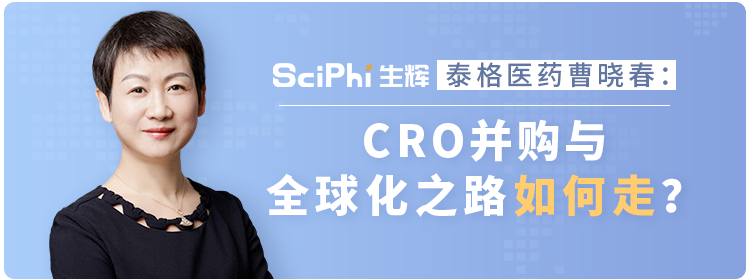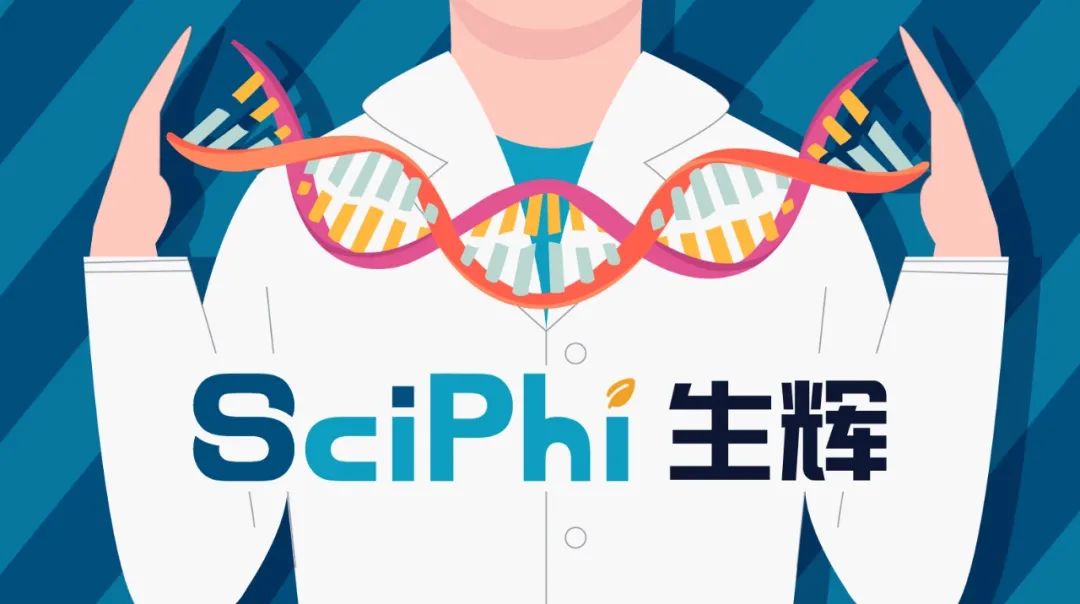 Say goodbye to nightmares? The Apple Watch application NightWare has recently received approval from the U.S. Food and Drug Administration (FDA) for market sales. NightWare, which sounds like “nightwear,” uses data from the smartwatch’s motion and heart rate to detect the wearer’s nightmares and vibrate the wristband accordingly, interrupting nightmares without disturbing sleep, effectively terminating nightmares caused by conditions such as PTSD (Post-Traumatic Stress Disorder). The use of this application requires a doctor’s prescription. The successful crossover into healthcare has made Apple’s strategy to penetrate the medical industry with the Apple Watch increasingly clear.
Say goodbye to nightmares? The Apple Watch application NightWare has recently received approval from the U.S. Food and Drug Administration (FDA) for market sales. NightWare, which sounds like “nightwear,” uses data from the smartwatch’s motion and heart rate to detect the wearer’s nightmares and vibrate the wristband accordingly, interrupting nightmares without disturbing sleep, effectively terminating nightmares caused by conditions such as PTSD (Post-Traumatic Stress Disorder). The use of this application requires a doctor’s prescription. The successful crossover into healthcare has made Apple’s strategy to penetrate the medical industry with the Apple Watch increasingly clear.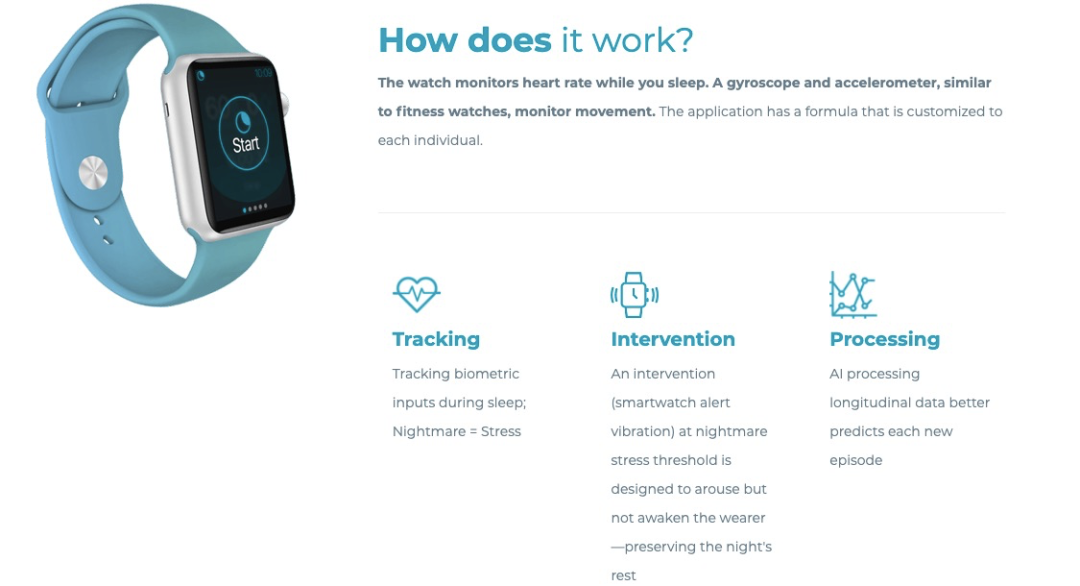 Image: Apple Watch NightWare (Source: Apple)Turning our attention to the domestic market, Huawei has announced that it has successfully obtained a registration certificate from the National Medical Products Administration (NMPA) of China through a pilot program in Guangdong Province. The product is a single-lead ECG collector for the wrist, used in Huawei’s Watch GT series, classified as a wearable medical device. Thus, Huawei’s business scope has expanded from sales to the development and sales of medical devices.
Image: Apple Watch NightWare (Source: Apple)Turning our attention to the domestic market, Huawei has announced that it has successfully obtained a registration certificate from the National Medical Products Administration (NMPA) of China through a pilot program in Guangdong Province. The product is a single-lead ECG collector for the wrist, used in Huawei’s Watch GT series, classified as a wearable medical device. Thus, Huawei’s business scope has expanded from sales to the development and sales of medical devices. Image: Huawei Watch GT 2 product display, with “heart health” prominently featured (Source: Huawei)Suspense novelist Dan Brown once wrote in “The Da Vinci Code”: “There are no coincidences in the world, only inevitable results.” Observing the similar steps taken by Apple and Huawei, and reflecting on their past actions, we find that this competition among tech giants to infiltrate the medical device industry has long been in the making.As early as 2014, both Apple and Huawei signaled their intentions to make significant strides in the healthcare sector.
Image: Huawei Watch GT 2 product display, with “heart health” prominently featured (Source: Huawei)Suspense novelist Dan Brown once wrote in “The Da Vinci Code”: “There are no coincidences in the world, only inevitable results.” Observing the similar steps taken by Apple and Huawei, and reflecting on their past actions, we find that this competition among tech giants to infiltrate the medical device industry has long been in the making.As early as 2014, both Apple and Huawei signaled their intentions to make significant strides in the healthcare sector.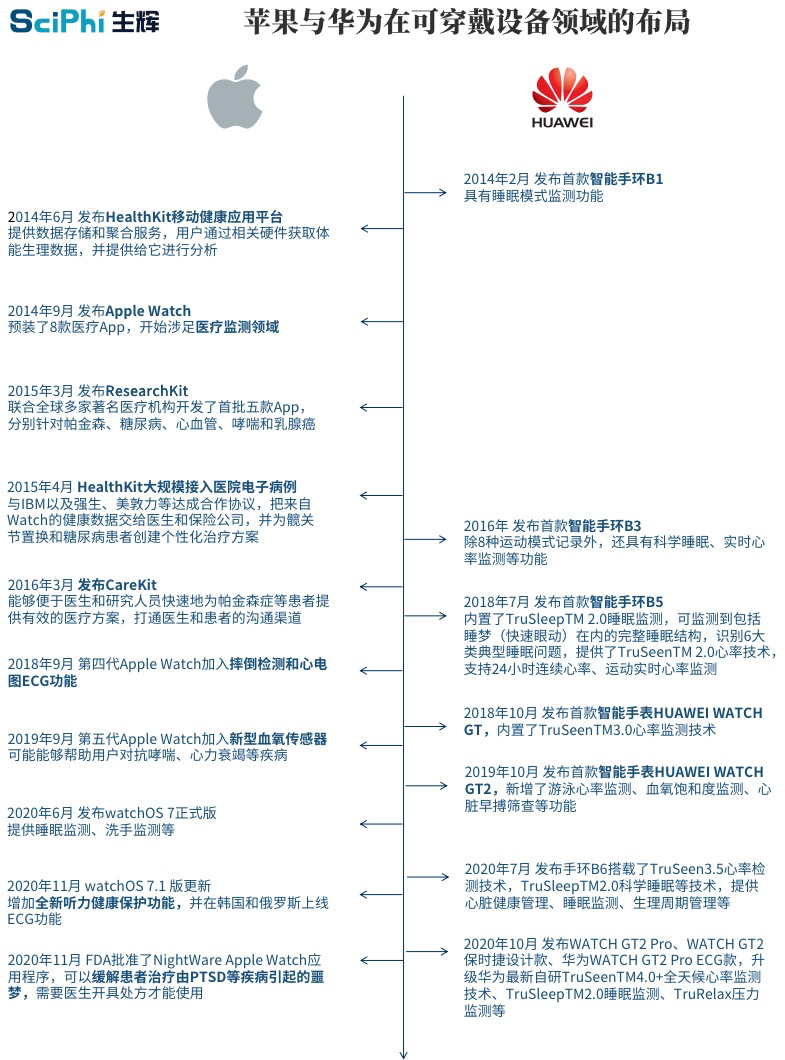 Image: Apple’s and Huawei’s strategies in the wearable device sector (Source: compiled from public data by Shenghui)Upon closely examining the entire process of Apple and Huawei in the healthcare sector, we can see that their focuses differ significantly. Firstly, Apple uses the Apple Watch as a platform, supported by three different types of “Kit” data platforms, to create a highly integrated and complementary digital healthcare segment. Within Apple’s ecosystem, various smart devices are interconnected, allowing for the collection of vast amounts of data samples. All of Apple’s “Kits” are data application modules aimed at third-party developers. The HealthKit mobile health application platform, launched with iOS 8 in 2014, provides data storage and aggregation services, representing Apple’s promotion of the concept of public health data interoperability; ResearchKit, released in the spring of 2015, connected several renowned medical institutions globally and developed the first five apps, enabling researchers to obtain a wealth of primary data for research; CareKit, launched in the spring of 2016, is a patient-centered framework for one-on-one patient services that shares health data between doctors and patients, facilitating communication between them. With these three mobile application platforms, the iPhone has become a personal hub for all medical information, while the Apple Watch serves as the core of Apple’s healthcare ecosystem, penetrating the core of medical care through the monitoring of various health indicators. In contrast, Huawei has taken a differentiated path through smart bands and sports smartwatches.The smart sports watch has a lighter system and limited application expandability. Currently, Huawei is collaborating with Professor Chen Yundai and Professor Guo Yutao’s innovative team from the Cardiology Department of 301 Hospital, hoping to explore the application of mobile health (mHealth) technology in the management of cardiovascular diseases. Huawei officially stated that the purpose of this collaboration is to combine mobile technology and smart wearable devices with specialized disease management methods for the prevention of cardiovascular diseases at various levels.
Image: Apple’s and Huawei’s strategies in the wearable device sector (Source: compiled from public data by Shenghui)Upon closely examining the entire process of Apple and Huawei in the healthcare sector, we can see that their focuses differ significantly. Firstly, Apple uses the Apple Watch as a platform, supported by three different types of “Kit” data platforms, to create a highly integrated and complementary digital healthcare segment. Within Apple’s ecosystem, various smart devices are interconnected, allowing for the collection of vast amounts of data samples. All of Apple’s “Kits” are data application modules aimed at third-party developers. The HealthKit mobile health application platform, launched with iOS 8 in 2014, provides data storage and aggregation services, representing Apple’s promotion of the concept of public health data interoperability; ResearchKit, released in the spring of 2015, connected several renowned medical institutions globally and developed the first five apps, enabling researchers to obtain a wealth of primary data for research; CareKit, launched in the spring of 2016, is a patient-centered framework for one-on-one patient services that shares health data between doctors and patients, facilitating communication between them. With these three mobile application platforms, the iPhone has become a personal hub for all medical information, while the Apple Watch serves as the core of Apple’s healthcare ecosystem, penetrating the core of medical care through the monitoring of various health indicators. In contrast, Huawei has taken a differentiated path through smart bands and sports smartwatches.The smart sports watch has a lighter system and limited application expandability. Currently, Huawei is collaborating with Professor Chen Yundai and Professor Guo Yutao’s innovative team from the Cardiology Department of 301 Hospital, hoping to explore the application of mobile health (mHealth) technology in the management of cardiovascular diseases. Huawei officially stated that the purpose of this collaboration is to combine mobile technology and smart wearable devices with specialized disease management methods for the prevention of cardiovascular diseases at various levels.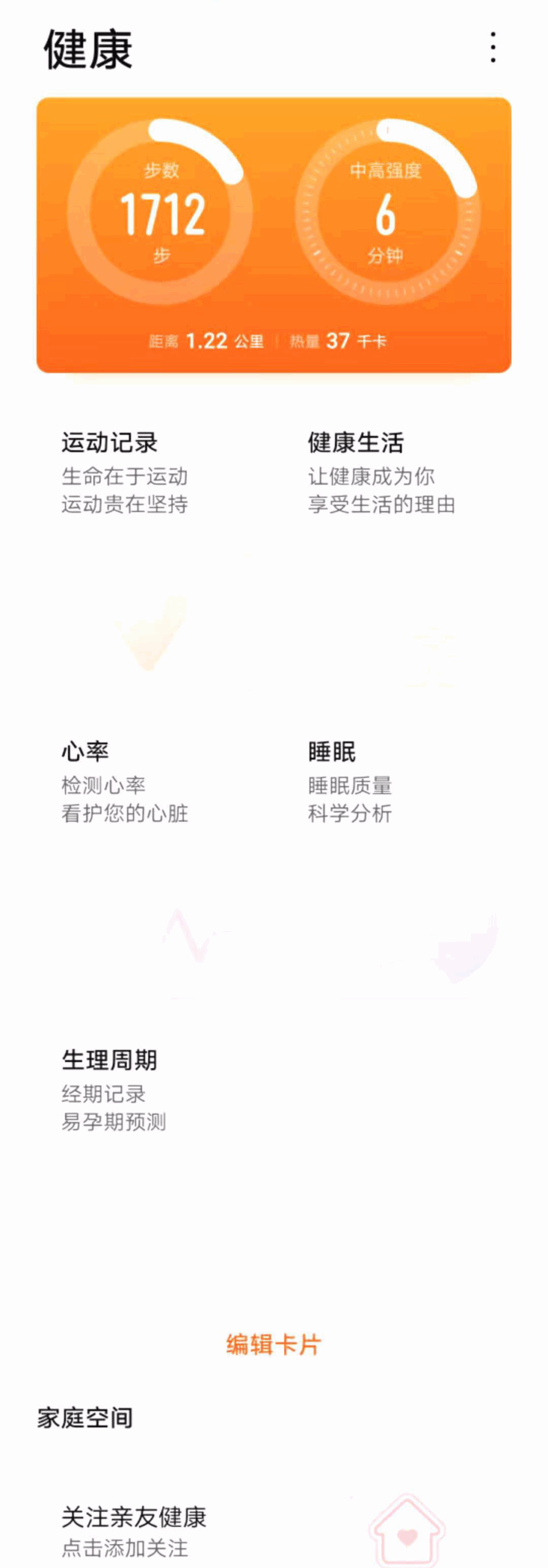 Image: Sports health application interface, lacking an expandable program section (Source: Huawei Mobile)Compared to Apple’s hundreds of healthcare apps expanded through data application platforms, Huawei’s sports watch currently only has the “heart rate” application (as shown above), which has a narrow coverage and is somewhat lacking.However, Huawei has long been leveraging its advantages in big data, cloud computing, and the Internet of Things in areas such as digital hospitals, regional health information systems, and tiered medical services.This entry into the medical device sector brings new possibilities.
Image: Sports health application interface, lacking an expandable program section (Source: Huawei Mobile)Compared to Apple’s hundreds of healthcare apps expanded through data application platforms, Huawei’s sports watch currently only has the “heart rate” application (as shown above), which has a narrow coverage and is somewhat lacking.However, Huawei has long been leveraging its advantages in big data, cloud computing, and the Internet of Things in areas such as digital hospitals, regional health information systems, and tiered medical services.This entry into the medical device sector brings new possibilities.
Don’t speculate, respond: Is Huawei really going to make a big push into the medical industry?
The nearly seamless approval news between Huawei and Apple seems to signal that another competition has begun, this time in the healthcare sector. In this regard, Shenghui contacted an insider from Huawei to discuss the differences and gaps between Huawei’s and Apple’s products, as well as Huawei’s future plans.Shenghui:Huawei’s new smartwatch, the HUAWEI Watch GT2 Pro, has just received a medical device license from the National Medical Products Administration. This news has drawn attention to Huawei’s layout in wearable devices, healthcare, and digital medicine. How long has Huawei been planning in the digital healthcare space?A:Currently, only a few models of Huawei’s sports watches carry the ECG function, but Huawei has been laying out wearable devices for a long time. At this stage, wearable devices are primarily focused on health, exercise, and sleep, with health being a key focus for Huawei in its wearable device strategy. Huawei has previously collaborated with some domestic hospitals. However, this is the first time we are launching products with ECG functionality.Shenghui:The FDA has approved an Apple Watch application called NightWare, which claims to assist in intervening nightmares caused by disorders like PTSD. Does Huawei have plans in this area? Will we also develop wearable devices that can provide auxiliary treatment solutions, making the watch a true part of digital healthcare?A:To be honest, Apple is relatively ahead in many technical aspects. However, in the health sector, including heart health monitoring and apnea alerts on Huawei watches, we are collaborating with 301 Hospital. We have also developed a heart health research app in collaboration with 301 Hospital.However, our current focus is not on medical devices, as the entry barriers and qualification requirements for medical devices are quite high. We can only provide a reference for physical health status, a supportive means, and not as a basis for diagnosis and treatment. We will wait for clearer policies before developing in this direction.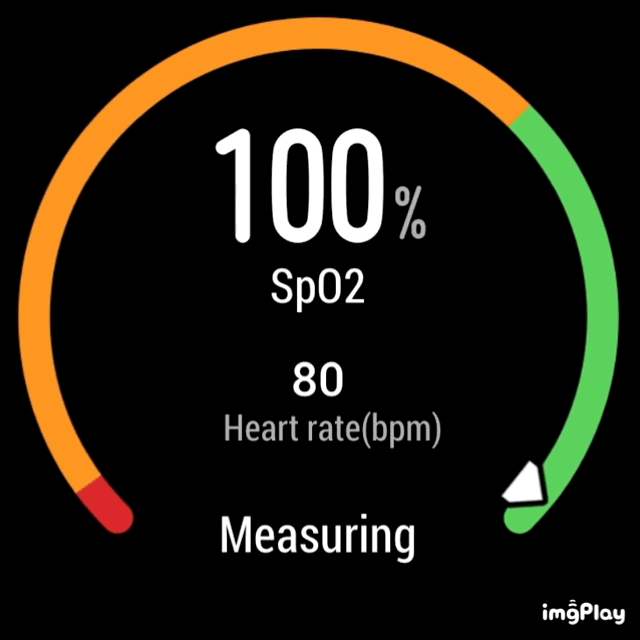 GIF: Huawei Watch GT2 Pro sports heart rate detection function (Source: Huawei)Shenghui:What do you think about the media’s claim that Huawei has been “following” Apple in launching products?A:As I said, we must acknowledge that Apple is indeed a very powerful technology company, and they are very quick in innovation and exploration. However, in terms of wearable devices and health, Huawei also has its own layout and ideas. We are on two different tracks; the Apple Watch is a smart watch with many smart systems that can install various app tools, making it quite convenient. In contrast, the Huawei GT series watches are positioned as sports watches, focusing on long battery life, while Apple is still leading in the smart watch sector.However, Huawei still has two strategic directions in the healthcare sector. We will definitely analyze the development of competitors and study what they are using. But the accumulation of technology and the launch of products cannot be so rapid. In the entire industry, the information obtained is generally quite consistent, and it is common for products to be released a generation or half a generation ahead. For example, Huawei’s blood oxygen detection feature was implemented on the Watch GT 2 last year, and it was expected that Apple would include this feature in its next generation, which it did with the release of the Watch 6 this year.In the past, there may have been a phenomenon of “following” Apple, but at least at this stage, we have already moved past that situation.Shenghui:Currently, the heart detection functions primarily carried by the Huawei GT series watches are all independently developed by us. Will we create a platform for our products to connect with health detection and treatment apps developed by other companies in the future?A:Currently, our watches face a significant issue regarding expandability, which we must admit is still lacking. Even the latest Watch GT 2 Pro has added some app functionalities and is collaborating with some manufacturers to develop third-party software, but to be honest, this is our first attempt, and currently, we still have some gaps compared to Apple in terms of quantity. However, we do have plans to develop a fully smart watch, which is the Watch series. This was previously released, but due to battery life issues, it may not have been as popular. This has temporarily focused our attention on the sports watch GT series.But this does not mean we have given up on the Watch series smart watch; we do have development plans for it in the future.The reason Huawei chose to develop sports watches first was to differentiate from Apple’s smart watches, to develop the sports watch segment well, gain a certain market share, and then return to focus on smart watches.Data shows that in the domestic market, our sports watch products are selling better than Apple’s, and globally, our market share has become the largest, accounting for over twenty percent.In this context, we should see a Watch series smart watch released this year, and if limited by special circumstances, it may be as late as early next year. I estimate it should be soon; in terms of product planning, the watch category holds a relatively high position within Huawei, and the company is investing heavily in it.Apple currently hopes to make the smart watch a platform, and we are also looking to do the same, collaborating with more third parties in the future.Shenghui:OPPO has also launched an ECG watch; what functional differences does Huawei’s watch have compared to it?A:Actually, the principle of measuring ECG with the watch is similar across the board. Apple was the first to do this, launching the feature in 2018. The core principle is the same: there is an electrode on the back of the watch and another on the crown, and when measuring, another hand touches it, forming a single-lead circuit to obtain a single-lead ECG. Of course, it cannot be compared to the results from a hospital, where multiple electrodes are used for ECG measurements, but it can still provide significant reference value. So, the principle of watches with this function is quite similar; the differences lie in the algorithms and interpretations. However, Apple has long obtained FDA certification for the ECG function, while domestic certification has not been obtained, so this function cannot be used domestically. OPPO and Huawei have now both received Class II medical device certification from the National Medical Products Administration.Shenghui:Can the ECG function of wearable devices currently provide accurate data?A:To be honest, I think this function is merely a reference. Heart rate is certainly quite accurate, but atrial fibrillation requires professional medical analysis, and any suspected issues should be followed up with professional examinations. Huawei’s entry into the market with the ECG function, combined with the aforementioned health industry layout strategy, suggests that Huawei seems to be playing a long game. In this regard, analysts from CB Insights expressed their views to Shenghui, stating, “Just as Huawei transitioned from a telecommunications equipment manufacturer to the consumer sector, then to cloud computing, achieving great success in each field, it seems to embody a winner-takes-all posture. However, within Huawei, this is merely a natural extension of its ‘1+8+n’ strategy; the layout of wearable devices is just a natural result of Huawei’s integration into the broader context of the Internet of Everything.” But as the analyst noted, Huawei’s performance in other areas undoubtedly presents a possibility: once it begins to exert its strength, can Huawei once again seize the high ground in digital healthcare? Can it continue to “win”? Part of the answer may lie in the next generation of products.
GIF: Huawei Watch GT2 Pro sports heart rate detection function (Source: Huawei)Shenghui:What do you think about the media’s claim that Huawei has been “following” Apple in launching products?A:As I said, we must acknowledge that Apple is indeed a very powerful technology company, and they are very quick in innovation and exploration. However, in terms of wearable devices and health, Huawei also has its own layout and ideas. We are on two different tracks; the Apple Watch is a smart watch with many smart systems that can install various app tools, making it quite convenient. In contrast, the Huawei GT series watches are positioned as sports watches, focusing on long battery life, while Apple is still leading in the smart watch sector.However, Huawei still has two strategic directions in the healthcare sector. We will definitely analyze the development of competitors and study what they are using. But the accumulation of technology and the launch of products cannot be so rapid. In the entire industry, the information obtained is generally quite consistent, and it is common for products to be released a generation or half a generation ahead. For example, Huawei’s blood oxygen detection feature was implemented on the Watch GT 2 last year, and it was expected that Apple would include this feature in its next generation, which it did with the release of the Watch 6 this year.In the past, there may have been a phenomenon of “following” Apple, but at least at this stage, we have already moved past that situation.Shenghui:Currently, the heart detection functions primarily carried by the Huawei GT series watches are all independently developed by us. Will we create a platform for our products to connect with health detection and treatment apps developed by other companies in the future?A:Currently, our watches face a significant issue regarding expandability, which we must admit is still lacking. Even the latest Watch GT 2 Pro has added some app functionalities and is collaborating with some manufacturers to develop third-party software, but to be honest, this is our first attempt, and currently, we still have some gaps compared to Apple in terms of quantity. However, we do have plans to develop a fully smart watch, which is the Watch series. This was previously released, but due to battery life issues, it may not have been as popular. This has temporarily focused our attention on the sports watch GT series.But this does not mean we have given up on the Watch series smart watch; we do have development plans for it in the future.The reason Huawei chose to develop sports watches first was to differentiate from Apple’s smart watches, to develop the sports watch segment well, gain a certain market share, and then return to focus on smart watches.Data shows that in the domestic market, our sports watch products are selling better than Apple’s, and globally, our market share has become the largest, accounting for over twenty percent.In this context, we should see a Watch series smart watch released this year, and if limited by special circumstances, it may be as late as early next year. I estimate it should be soon; in terms of product planning, the watch category holds a relatively high position within Huawei, and the company is investing heavily in it.Apple currently hopes to make the smart watch a platform, and we are also looking to do the same, collaborating with more third parties in the future.Shenghui:OPPO has also launched an ECG watch; what functional differences does Huawei’s watch have compared to it?A:Actually, the principle of measuring ECG with the watch is similar across the board. Apple was the first to do this, launching the feature in 2018. The core principle is the same: there is an electrode on the back of the watch and another on the crown, and when measuring, another hand touches it, forming a single-lead circuit to obtain a single-lead ECG. Of course, it cannot be compared to the results from a hospital, where multiple electrodes are used for ECG measurements, but it can still provide significant reference value. So, the principle of watches with this function is quite similar; the differences lie in the algorithms and interpretations. However, Apple has long obtained FDA certification for the ECG function, while domestic certification has not been obtained, so this function cannot be used domestically. OPPO and Huawei have now both received Class II medical device certification from the National Medical Products Administration.Shenghui:Can the ECG function of wearable devices currently provide accurate data?A:To be honest, I think this function is merely a reference. Heart rate is certainly quite accurate, but atrial fibrillation requires professional medical analysis, and any suspected issues should be followed up with professional examinations. Huawei’s entry into the market with the ECG function, combined with the aforementioned health industry layout strategy, suggests that Huawei seems to be playing a long game. In this regard, analysts from CB Insights expressed their views to Shenghui, stating, “Just as Huawei transitioned from a telecommunications equipment manufacturer to the consumer sector, then to cloud computing, achieving great success in each field, it seems to embody a winner-takes-all posture. However, within Huawei, this is merely a natural extension of its ‘1+8+n’ strategy; the layout of wearable devices is just a natural result of Huawei’s integration into the broader context of the Internet of Everything.” But as the analyst noted, Huawei’s performance in other areas undoubtedly presents a possibility: once it begins to exert its strength, can Huawei once again seize the high ground in digital healthcare? Can it continue to “win”? Part of the answer may lie in the next generation of products.
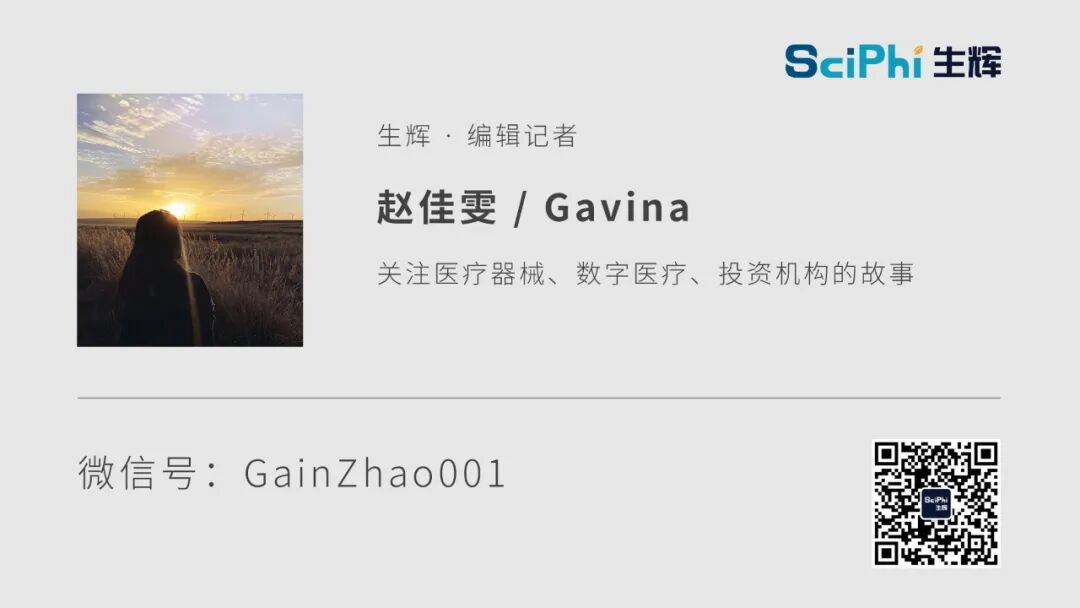 -End-
-End-